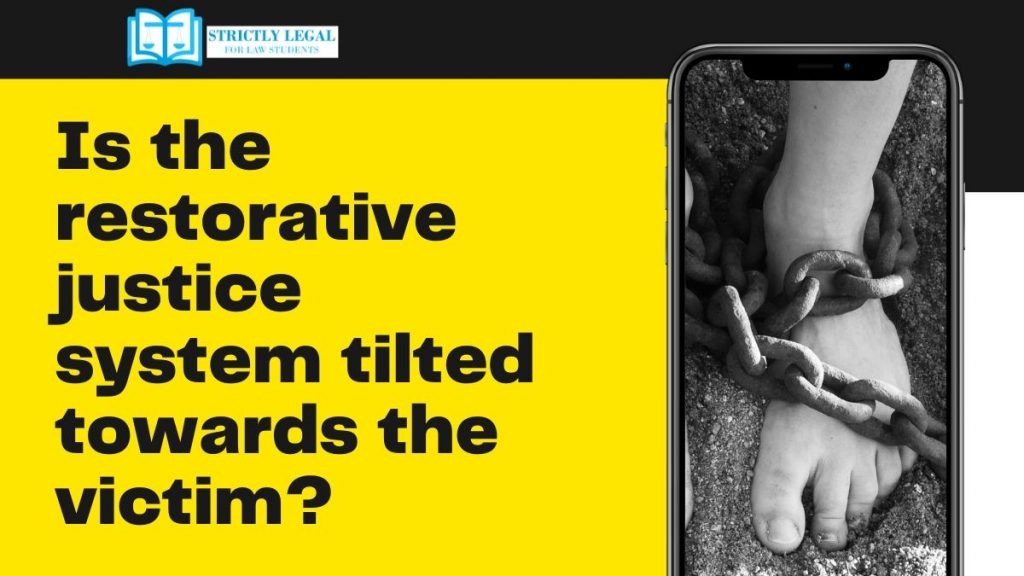Restorative Justice, as per Merriam– Webster dictionary means “to restore”. It began in Canada in the mid-1970s as an idea for victim-offender reconciliation. The wider purpose of this model is to restore the victim to its original position while preserving the web of relationships among the victim, offender and the community. Here, the needs of the victim and the community have been given priority by involving them in the criminal procedure so that they do not feel ignorant.
This blog post has been submitted by Anjali Tripathi, a second year student pursuing B.COM L.LB(Hons.) From Institute of law, Nirma University
Table of Contents
Provisions reflective of Restorative Justice-
Under Criminal law, the major provisions reflective of restorative values are Section 320 of CRPC and Section 482 of CRPC. Here the object of section 320 is to promote the compromise among the parties so that they could be restored to their original positions. Further, section 482 confers the High-court with an inherent power to quash an FIR or complaint to prevent abuse of the process of any Court or otherwise to secure the ends of justice. Additionally, arbitration and mediation are also some of the best examples to explain Restorative Justice. It allows parties involved in litigation to go for an out of court settlement, which is one of the most feasible solutions for the parties in conflict.
Drawbacks of Restorative Justice system
Just as every coin has another side similarly this model also has drawbacks attached to it. Still, more than half of the majority is not aware of the fact that they can approach restorative justice instead of going for the litigation only. This drawback affects the progress of restorative justice negatively. Majorly this system leads to a violation of fair justice. As, in the beginning, it starts with the inclusion of the victim but in the end, it again gets tilted towards the offender which shows overall, the offender is the only one who is at the benefit here. Further, if talking about Compromise under restorative justice then everything here is dependent on the consent of the victim without which the system loses at its implementation.
The main influencer which attracts the people towards the restorative system is that it creates a win-win situation for both offender and victim, as the victim gets restored to its original position and the offender get acquitted. (S. Vishwanath v. the State of Kerala, (1999) 113 STC 182. )
But, held in a judgement in case if the offender is unsatisfied with the restorative award then there is no scope for further review or appeal in the said case. Therefore it indicates that compromise here is binding which could not be reversed even though the victim is in dire need of the same.
The belief here is also that the possibilities of offenders repeating the same offence get drastically decreased. The reason behind the same is that this system lets the offender realize the negative impacts of his act on the victim and community. But, still, it is not a straightjacket formula to make a transformation. In practice, it is not always able to prevent offenders because sometimes offenders develop a protective parameter. He attempts comparatively more offences based on the belief that the restorative system will once again create a win-win situation which will result in the acquittal of the offender.
The most debatable provision of restorative justice
Section 482 of Cprc is the most debatable provision in the restorative justice system. It talks about quashing where the High court has the inherent power to quash the FIR even in non-compoundable offences. Here, the conflict arises the most because there is a huge misapplication of quashing being done. Sometimes it has also been observed that quashing becomes a way for offenders to get out of even the most heinous offences. E.g., Section 498A of IPC talks about harassment of women, it is a non-compoundable offence to help women’s victims of their husbands or his family’s ire, but the court by allowing quashing here is making the women more helpless. As of now due to the absence of punishment, there are huge chances of these offenders repeating the same offences against the women. Further, in the case of RAJEEV KOURAV v/s BAISAHAB AND ORS, it has been found that the court had inappropriately quashed the FIR in the matrimonial case where the wife along with her two children had committed suicide. Therefore it is visible how effective this system is.
A system is an expensive tool acting in favour of the rich-
Nowadays, the restorative system is biasedly acting as a tool in favor of the rich as people belonging to the inferior class are not able to bear such legal expenses and they get compelled to compromise with fair justice. Moreover, the myth that restorative system is less expensive than litigation has also been crushed by one of the studies done by don Corporate Counsel, which showed that out of 19 cases arbitration was more expensive than litigation and the minimum time taken in arbitration was comparatively 2 months more than in litigation cases.
Lack of effective negotiation makes the utility of restorative justice less effective
The effectiveness of the system is based on how potently the parties are negotiating; only an effective negotiation can lead towards the healthy compromise but in real life bringing the parties together is not an easy task. And even this face to face negotiation sometimes affects their relationship more badly if the offender is cruel and showing no empathy towards a victim. Additionally, due to this meeting, the same cruel incident starts flashing again in front of the victim which sometimes bought physiological harm to the victim.[8]
The power gets transmitted in a single hand-
In the modern era, every contract or agreement either happening digitally or manually definitely comprises of an arbitration clause to resolve future conflicts. Here, the acceptor does not have any say in the terms of arbitration mentioned in the agreement; they are bound to accept it which later biasedly works in the favor of the company or offee. Hence, it depicts that compromise does not always create a win-win situation for both parties. But, sometimes it transmits the whole power in the hands of people at a superior position.
Conclusion
As a conclusion, it could be derived that the restorative system is not fully adhered to the principle of fair justice which somehow makes it a secondary choice. Hence, it is high time to resolve the drawbacks attached to this model and to go forward with the changing needs of society. Now, the criminal justice system needs to bring innovative changes in the implementation of the system. Further, there is also a need to make people aware of the Restorative justice system through legal awareness, so that, people can rely on it just like they believe in the litigation.

Users not registered with Strictlylegal can Email us their content and the same are posted through this account. In case of abuse, kindly let us know at [email protected]




